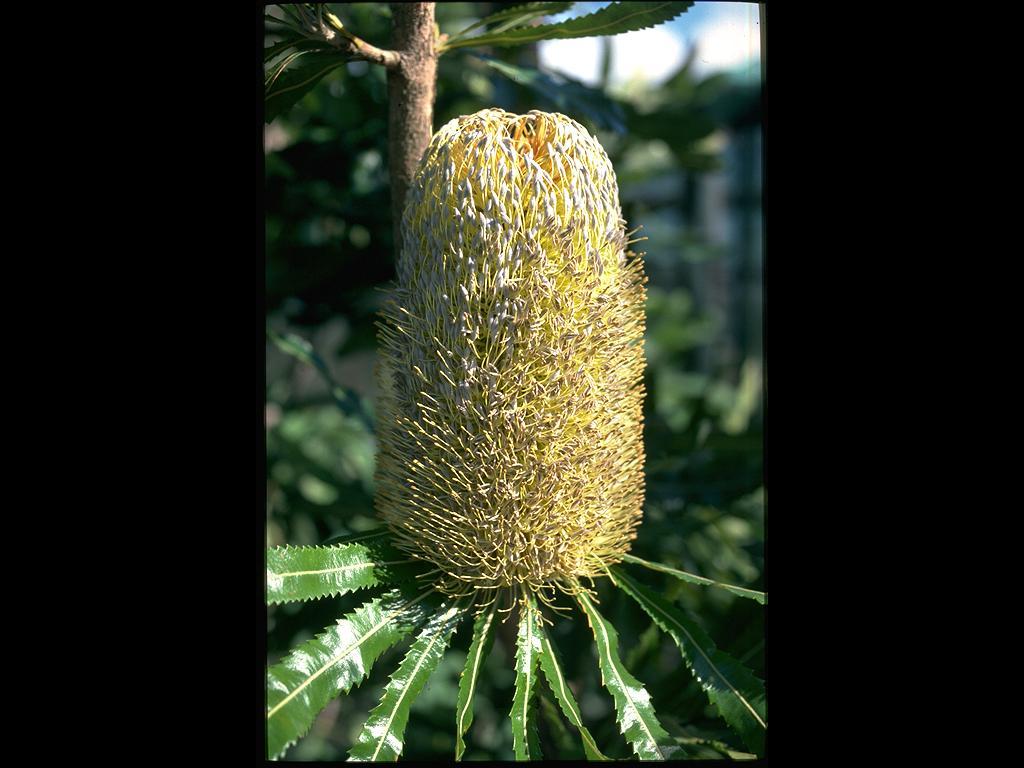Banksia serrata 'Superman'
- File Number
- 555
- ACRA Field Book Number
- 529
- Registration Date
- 04/08/2002
- Application Received
- 01/05/1995
- Family
- Proteaceae
- Cultivar Name
- Banksia serrata 'Superman'
- Origin
- Banksia 'Superman' is a variety of B. serrata found growing in the wild near Nambucca Heads, NSW. It was discovered during mapping for the Banksia Atlas in1986 and mention is made of it in the subsequent publication (1988:225). It occurs in small stands between Nambucca Heads and Grassy Head, NSW. In all cases the plants were growing close to water along the edge of streams or in poorly drained sites. Specimens were sent to the botanic gardens in Sydney and Perth to be deposited in the Herbaria. At the time it was suggested that the variety be accorded sub-species status. This has not occurred. The form comes true to seed. The specimen received by ACRA was grown in a garden and was approximately 6 years old.
- Characteristics
- Small tree growing to 6 metres in height with a spread of 5 metres. Leaves alternate, xeromorphic, oblanceolate, 32 cm long by 4 cm wide with evenly serrated margins, glabrous, dark green and shiny on upper surface, lighter green and penniveined on under-surface with a defined yellowish-green mid-rib. Flower inflorescences terminal spikes 26 cm long by 13 cm wide on short branches off main trunk. Perianth tubular in bud, splitting into segments where the style protrudes. Anthers sessile in the concave tips of the perianth segments. Ovary sessile, style long and wiry, 6 cm long, protruding from the slit in the perianth and curving out in a hook shape. Fruit a follicle, opening in two hard woody obtuse valves set transversely on the rachis. Seeds 2 with a terminal membranous wing, the seeds separated by a plate. Peak flowering is from January to March. Diagnosis: This form is much larger in both leaf size and flower size to the normal range for Banksia serrata as documented by in 'Students Flora of North Eastern New South Wales'. This gives a range of 8-16 cm x 2-4 cm for leaves and 8-16 cm x 8-10 cm for spikes. The inflorescence is similar to B. serrata except for the size of the brushes. Differs from B. serrata in: * leaves almost twice as long as type form (up to 32cm, type form 7-22cm) * inflorescences much larger than type form (up to 27cm vs. 7-15cm) * fruiting cones much larger than type form (up to 27cm long)
- Cultivation
- The cultivar is yet to be introduced to commerce. Trials in Armidale have shown that the plant is not drought tolerant and requires regular watering. It is frost tolerant down to a screen temperature of about -5° C but the tips of leaves and new growth are burnt in winter. Propagation has been by seed. In its natural habitat the species is found beside saltwater creeks and on shorelines and is salt tolerant. The trial plantings are on a well drained basalt site which is watered daily with calcium rich bore water. At two years the specimens grew to 1.5m This cultivar is fast-growing in cultivation with an annual growth rate of over a metre in the length of upright branches. The tips are affected by frosts but plants recover quickly. This specimen has been planted in well-drained soil near a shade house where it receives daily watering through run-off. Another interesting feature is splitting on the trunk which appears to be a strategy for trunk widening. The trunk is short, brown and corky in appearance. The first flower spike appeared 5 years after planting.
- Publication
- Payne, W.H. (2001), Wildflower Cultivars. Australian Plants 21(166): 67
- Colour Coding
- RHS 1995 Leaves upper: green group 137A Leaves lower: green group 138B Perianth: greyed-green group 198CStyle: greyed yellow group 160BREFERENCES:'The Banksia Book', A George, Kangaroo Press'Students Flora of North Eastern New South Wales' N C W Beadle, UNE,Armidale, 1972.
- Propagation
- Cuttings
- Applicant Name
- -
- Uses
- As part of the shrubbery, screen planting or as a showy feature plant
- Availability
- Unknown
- ANBG Accession Numbers
- ACC555, ACRA529, CBG9518035
- NSL ID
- -
